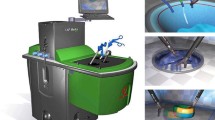Abstract
Background
Disruptions to surgical workflow have been correlated with an increase in surgical errors and suboptimal outcomes in patient safety measures. Yet, our ability to quantify such threats to patient safety remains inadequate. Data are needed to gauge how the laparoscopic operating room work environment, where the visual and motor axes are no longer aligned, contributes to such disruptions. We used time motion analysis techniques to measure surgeon attention during laparoscopic cholecystectomy in order to characterize disruptive events imposed by the work environment of the OR. In this investigation we identify attention disruptions as they occur in terms of the operating surgeon’s gaze. We then quantify such disruptions and also seek to establish what occasioned them.
Methods
Ten laparoscopic cholecystectomy procedures were recorded with both intra- and extracorporeal cameras. The views were synchronized to produce a video that was subsequently analyzed by a single independent observer. Each time the surgeon’s gaze was diverted from the operation’s video display, the event was recorded via time-stamp. The reason for looking away (e.g., instrument exchange), when discernable, was also recorded and categorized. Disruptions were then reviewed and analyzed by an interdisciplinary team of surgeons and human factors experts.
Results
Gaze disruptions were classified into one of four causal categories: instrument exchange, extracorporeal work, equipment troubleshooting, and communication. On average, 40 breaks occurred in operating surgeon attention per 15 min of operating time. The most frequent reasons for these disruptions involved instrument exchange (38%) and downward gaze for extracorporeal work (28%).
Conclusions
This study of laparoscopic cholecystectomy performance reveals a high gaze disruption rate in the current operating room work environment. Improvements aimed at reducing such disruptions—and thus potentially surgical error—should center on better instrument design and realigning the axis between surgeon’s eye and visual display.

Similar content being viewed by others
References
Couch NP, Tilney NL, Rayner AA, Moore FD (1981) The high cost of low-frequency events: the anatomy and economics of surgical mishaps. N Engl J Med 304:634–637
Wiegmann DA, El Bardissi AW, Dearani JA, Daly RC, Sundt TM (2007) Disruptions in surgical flow and their relationship to surgical errors: an exploratory investigation. Surgery 142:658–665
Endsley MR, Robertson MM (2000) Training for situation awareness in individuals and teams. In: Endsley MR, Garland DJ (eds) Situation awareness analysis and measurement. Lawrence Erlbaum Associates, Mahwah, NJ, p 350
Krause SS (2003) Aircraft safety: accident investigations, analysis and applications, 2nd edn. McGraw-Hill Professional, New York
Christian CK, Gustafson ML, Roth EM, Sheridan TB, Gandhi TK, Dwyer K, Zinner MJ, Dierks MM (2006) A prospective study of patient safety in the operating room. Surgery 139:159–173
Middendorf J, Kalish A (1996) The “change-up” in lectures. Natl Teach Learn Forum 5:1–5
Ratwani RM, Andrews AE, Sousk J, Trafton JG (2008) The effect of interruption modality on primary task resumption. In: Proceedings of the annual meeting of the Human Factors and Ergonomics Society, New York, 22–26 September 2008. Human Factors and Ergonomics Society, Santa Monica, CA, pp 393–397(5). Available at http://www.nrl.navy.mil/aic/iss/pubs/ratwani.hfes08.pdf. Accessed 3 December 2009
Ibbotson JA, MacKenzie CL, Cao CGL, Lomax AJ (1999) Gaze patterns in laparoscopic surgery. In: Westwood JD, Hoffman HM, Robb RA, Stredney D (eds) Medicine meets virtual reality: 7. IOS Press, Washington, DC, p 154
van Veelen MA, Jakimowicz JJ, Kazemier G (2004) Improved physical ergonomics of laparoscopic surgery. Minim Invasive Ther Allied Technol 13:161–166
Lee G, Lee T, Dexter D, Klein R, Park A (2007) Methodological infrastructure in surgical ergonomics: a review of tasks, models, and measurement systems. Surg Innov 14:153–167
van Det MJ, Meijerink WJ, Hoff C, van Veelen MA, Pierie JP (2008) Ergonomic assessment of neck posture in the minimally invasive surgery suite during laparoscopic cholecystectomy. Surg Endosc 22:2421–2427
Healey AN, Sevdalis N, Vincent CA (2006) Measuring intra-operative interference from distraction and interruption observed in the operating theatre. Ergonomics 49:589–604
Sevdalis N, Forrest D, Undre S, Darzi A, Vincent C (2008) Annoyances, disruptions, and interruptions in surgery: the Disruptions in Surgery Index (DiSI). World J Surg 32:1643–1650
Geryane MH, Hanna GB, Cuschieri A (2004) Time-motion analysis of operation theater time use during laparoscopic cholecystectomy by surgical specialist residents. Surg Endosc 18:1597–1600
Omar AM, Wade NJ, Brown SI, Cuschieri A (2004) Assessing the benefits of ‘gaze-down’ display location in complex tasks. Surg Endosc 19:105–108
Disclosures
Drs. Erica Sutton, Yassar Youssef, Nora Meenaghan, Carlos Godinez, Yan Xiao, Tommy Lee, David Dexter, and Adrian Park have no conflict of interest or financial ties to disclose.
Author information
Authors and Affiliations
Corresponding author
Rights and permissions
About this article
Cite this article
Sutton, E., Youssef, Y., Meenaghan, N. et al. Gaze disruptions experienced by the laparoscopic operating surgeon. Surg Endosc 24, 1240–1244 (2010). https://doi.org/10.1007/s00464-009-0753-3
Received:
Accepted:
Published:
Issue Date:
DOI: https://doi.org/10.1007/s00464-009-0753-3




